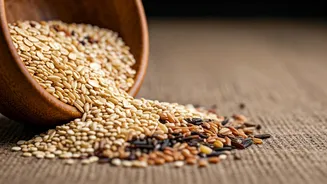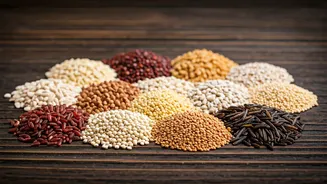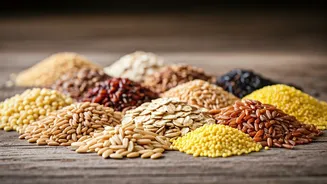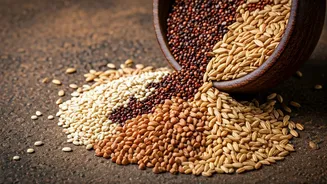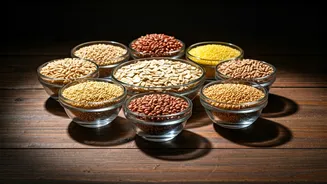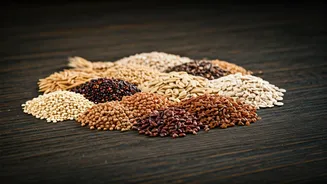Spinach: Nutrient Powerhouse
Spinach is a leafy green vegetable that is packed with essential nutrients, making it a great choice for people with diabetes. It is exceptionally low
in carbohydrates and calories, which is crucial for blood sugar control. Spinach is rich in fiber, which slows down the absorption of sugar, preventing sudden spikes in blood glucose levels. Furthermore, it contains antioxidants like lutein and zeaxanthin, which are beneficial for eye health, an important consideration for diabetics who are at higher risk of eye-related complications. Regular consumption of spinach can help improve insulin sensitivity, supporting better glucose management. You can enjoy spinach in salads, smoothies, or sautéed as a side dish, making it a versatile addition to any diabetic-friendly meal plan. Including spinach in your diet provides a natural way to support blood sugar regulation and overall health. With its high nutrient density, spinach delivers significant health benefits with minimal impact on blood sugar levels. This makes it an ideal food to incorporate into your daily meals to assist in your health regime and improve your quality of life.
Broccoli: Fiber-Rich Friend
Broccoli, a member of the cruciferous vegetable family, is another excellent choice for diabetes management. It is a fantastic source of fiber, which helps regulate blood sugar levels by slowing down digestion and the absorption of glucose. Broccoli also contains glucosinolates, which have been shown to improve insulin sensitivity, aiding in how the body uses insulin. This vegetable is rich in vitamins C and K, as well as several minerals essential for overall health. Broccoli's high fiber content can also help you feel fuller for longer, assisting in weight management, which is often a critical factor in diabetes control. Studies indicate that consuming broccoli can significantly reduce the risk of type 2 diabetes. Whether you choose to steam, roast, or stir-fry it, broccoli fits easily into various meal plans. Regular consumption of broccoli can be highly beneficial for individuals with diabetes by offering key nutrients and supporting better blood sugar control, helping with overall health and fitness. Incorporating broccoli into your diet is a flavorful and effective strategy for managing diabetes, providing both nutritional advantages and helping to prevent complications.
Bell Peppers: Colorful Choice
Bell peppers, available in various vibrant colors, are low in carbohydrates and rich in vitamins and antioxidants, making them an excellent choice for diabetics. These peppers offer a good source of vitamin C, which is known to boost the immune system and protect against cellular damage. Bell peppers contain very little natural sugars, contributing minimally to any spike in blood glucose levels. They are packed with fiber, further assisting with the control of blood sugar. Furthermore, the antioxidants in bell peppers can help reduce inflammation, a common issue for individuals with diabetes. These vegetables can be eaten raw in salads, grilled, roasted, or added to various dishes, adding both flavor and nutrition. Bell peppers offer a versatile and healthy option that supports the management of blood sugar while providing vital nutrients. Including bell peppers in your diet can contribute to a colorful and nutritionally rich meal plan, helping in overall health management and in the prevention of long-term health complications.
Green Beans: Low-Carb Option
Green beans, also known as string beans, are a low-carbohydrate vegetable that is a beneficial addition to a diabetic-friendly diet. They are a good source of fiber, which aids in slowing the absorption of sugar into the bloodstream, thus helping to keep blood sugar levels stable. Green beans also contain vitamins A, C, and K, as well as a range of beneficial minerals. The fiber content in green beans helps with promoting satiety, which helps with weight management. Additionally, green beans provide antioxidants that protect against cellular damage, which can be critical for individuals with diabetes. You can steam, boil, or saute green beans, making them an adaptable side dish. The low carbohydrate content of green beans makes it an ideal option to support overall health in those with diabetes and prevents any fluctuations in blood sugar. Incorporating green beans into your diet offers a simple and nutritious way to support blood sugar control and promote better health. They can be a consistent part of the diabetic diet, allowing the individual to meet the daily nutritional needs.
Cauliflower: Versatile and Healthy
Cauliflower, another cruciferous vegetable, is very low in carbohydrates and rich in fiber and vitamins, making it a great food for individuals with diabetes. It is also an excellent source of vitamin C and antioxidants, which help reduce inflammation and prevent cellular damage. Cauliflower’s high fiber content ensures that the absorption of glucose is slow, preventing sudden spikes in blood sugar levels. Cauliflower can also be a versatile substitute for higher-carbohydrate foods like rice or potatoes, which is beneficial for managing blood glucose levels. Whether you roast, steam, or puree it, cauliflower can be adapted into many dishes. Including cauliflower in your diet offers an adaptable and nourishing option for managing diabetes, supporting healthy blood sugar levels and providing essential nutrients. Using cauliflower in place of other carb-rich foods is very helpful for a healthy lifestyle. Regular consumption of cauliflower contributes to a diet rich in vitamins and nutrients.




